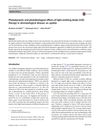Search
forLearn
5 / 6 resultslearn Neem Oil
natural substance from Neem tree with medicinal and pesticidal properties
learn Melatonin
hormone commonly taken for sleep aid has some topical benefits for hair
learn Azelaic Acid
acid used for antimicrobial, anti-inflammatory and anti-androgenic properties
learn Stem Cell Factor
Research
5 / 1000+ results
research Photodynamic and Photobiological Effects of Light-Emitting Diode Therapy in Dermatological Disease: An Update
LED therapy is safe and shows potential for treating skin conditions and promoting hair growth, but more research is needed.
research Shen-Ying-Yang-Zhen Formula Promotes Angiogenesis Around Hair Follicles, Alleviates Oxidative Stress, and Inhibits Hair Follicle Apoptosis Through the VEGF/Akt/Caspase-9 Signaling Axis
The formula may improve hair growth and health by boosting blood flow and reducing cell stress.

research Current Advances of Dendrobium Officinale Polysaccharides in Dermatology: A Literature Review
Dendrobium officinale polysaccharides may help with hair growth, skin moisturization, and protection against oxidative damage.

research Shedding Light on the Effects of Calorie Restriction and Its Mimetics on Skin Biology
Eating fewer calories may slow skin aging and improve skin health through various biological changes.

research Allergens of Permanent Hair Dyes Induce Epidermal Damage, Skin Barrier Loss, and IL-1 Alpha Increase in Epidermal In Vitro Model
Permanent hair dye mixtures can irritate and damage the skin.
Community Join
5 / 110 results
community Physio-metabolic method of treating androgenic alopecia. Cold receptors. The relationship between DHT, cold receptors, minoxidil and antiandrogens
Treating androgenic alopecia with minoxidil, finasteride, and antiandrogens, alongside exercise, cryotherapy, and natural substances to stimulate cold receptors for better hair growth. The method focuses on enhancing treatment effectiveness by considering environmental and behavioral factors and the role of cold receptors and muscle stress.
community Physio-metabolic method of treating androgenic alopecia. Cold receptors. The relationship between DHT, cold receptors, minoxidil and antiandrogens.
A method for treating androgenic alopecia using minoxidil, antiandrogens, exercise, and cold exposure to promote hair growth. Environmental factors and lifestyle changes, like diet and exercise, can improve treatment effectiveness.

community Compressed part of research of theory of androgenic/anabolitic balance. AGA h-responders analytic. Theory of physio-metabolitic method of anti AGA treatment
The treatment for androgenetic alopecia involves using finasteride and minoxidil with intense exercise and cold exposure to boost metabolism and reduce androgenic effects, potentially leading to hair regrowth. This approach may activate biological pathways for improved hair and overall health.
community Androgenetic alopecia is a skin disease: DHT-mediated skin disorders
Dihydrotestosterone (DHT) impacts various skin conditions, including Androgenetic alopecia and seborrheic dermatitis, by causing overactivity in sebaceous glands. Topical medications Tacrolimus and Clobetasol can reduce these inflammatory conditions, and treatments like RU58841, Minoxidil, and Finasteride may also be beneficial.
community The mechanism of androgenic alopecia
DHT may inhibit hair growth by affecting mitochondrial function, leading to hair follicle miniaturization. Treatments like minoxidil and PP405 may promote hair growth by altering metabolic pathways, potentially counteracting DHT's effects.